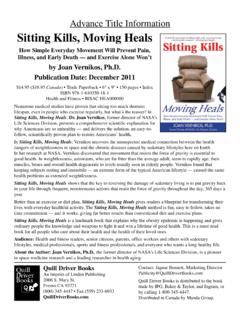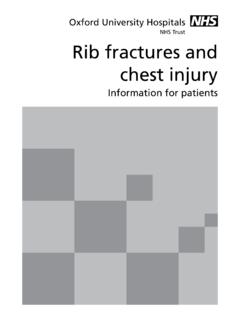Transcription of InfoSheet - Proximal Humerus Fracture2
1 InfoSheet Proximal Humerus Fractures David M. Klein, MD Kennedy - White Orthopaedic Center WHAT IS A Proximal Humerus FRACTURE? A Proximal Humerus fracture is the most common fracture of the shoulder, lying at the upper end of the Humerus , or arm bone. Fractures of this region are common both with high-energy injuries in people of all ages, as well as with simple falls in older people with osteoporosis. WHY DID I BREAK MY SHOULDER? Like any other bone in the body, the Proximal end of the Humerus will break if sufficient force is directed towards it. In younger people, fractures of the shoulder usually occur from high-energy trauma or from a fall from a height.
2 As people get older and their bones get weaker, a Proximal Humerus fracture can easily occur from a simple fall from a standing position. Osteoporosis is a frequent contributor to fractures of the Proximal Humerus , which is why they are known as "fragility fractures". HOW IS A Proximal Humerus FRACTURE TREATED? The vast majority of Proximal Humerus fractures will heal in a satisfactory position if you keep the arm loosely immobilized at your side and spend most of your time in an upright position, including when you sleep. This will allow gravity to align the pieces of the fracture. After the fragments start to heal, at about 3 to 6 weeks, you can be freer with motions of your arm.
3 Other types of Proximal Humerus fractures are better treated with surgery. Depending upon the type of fracture, surgical treatment can be directed towards repairing the fracture fragments, or replacing the broken pieces with a metal Proximal Humerus replacement, also known as a hemiarthroplasty. A hemiarthroplasty is often chosen for a fracture that has a high likelihood of collapsing even after it heals, or of not healing at all. HOW LONG DO Proximal Humerus FRACTURES TAKE TO HEAL? In adults of almost any age, Proximal Humerus fractures take four to eight weeks to heal well enough that they do not need any external support. Good strength is achieved by 12 weeks, but full healing with remodeling of the underlying bone may take 6 to 12 months.
4 Children heal faster, and may be solid enough to go without immobilization at 3 to 4 weeks. WHAT ARE THE TYPES OF Proximal Humerus FRACTURES? The number and type of major fragments provide the name for these fractures. The most common two-part fracture is a humeral neck fracture, separating the head of the Humerus from the shaft of the Humerus (shown in the picture above to the left). Another two-part fracture is a greater tuberosity Proximal Humerus Fractures Page 2 fracture, which is a type of bony rotator cuff injury. More complicated fractures are three-part and four-part fractures. Four-part fractures, involving the head, lesser tuberosity, greater tuberosity, and shaft are the most common fractures treated with a metal replacement piece (hemiarthroplasty).
5 WHAT IS THE MEANING OF THE WORD "PART" WITH RESPECT TO A Proximal Humerus FRACTURE? An often used fracture classification scheme uses the word "part" to represent a displaced segment. Even if there are multiple fracture lines through the Proximal Humerus , the fracture is considered a one-part fracture (which does not need surgery) unless the segments are displaced. Only when the segments are displaced or significantly angulated do they count as separate parts . WHAT DOES IT MEAN TO NEED A REDUCTION? If the position of a fracture is significantly out of place, the fracture will need to be put back into place to achieve a good result. The act of placing a fracture back into place is called a "reduction".
6 For fractures of the Proximal Humerus , reductions do not usually hold unless they are maintained in place by fixation devices, such as sutures, pins, plates, or screws. If a reduction is needed for a Proximal Humerus fracture, it is usually done in the operating room. WHY DO SOME Proximal Humerus FRACTURES "SLIP"? Even if the fragments of the Proximal Humerus are satisfactorily aligned, the fracture may not stay in this position. Loss of alignment is known as having the fracture "slip". Several characteristics make a fracture more likely to slip: unstable patterns, osteoporotic or otherwise poor quality bone, improper use of the sling, and excessive activity by the person with the fracture.
7 Because of the tendency for Proximal Humerus fractures to slip, we closely follow patients with x-rays for the first several weeks. That way, if the fracture does slip, surgical treatment can be discussed. WHAT TYPES OF FRACTURES OF THE Proximal Humerus ARE MORE LIKELY TO NEED SURGICAL TREATMENT? The least likely fractures to require surgical treatment are humeral neck fractures. Most of these will line up satisfactorily through the aid of gravity alone. The most likely Proximal Humerus fractures to require surgical treatment are displaced greater tuberosity fractures, as well as three- and four-part fractures. WHY ARE SOME OF THE DIFFERENT SURGICAL TREATMENTS CHOSEN?
8 In some cases, the fragments of a Proximal Humerus fracture are amenable to fixation. Fixation is achieved using suture material, wires, Pin and screw fixation for a 4-part fracture Proximal Humerus Fractures Page 3 pins, or plate and screws. In other cases, the fracture fragments are too thin and too fragile to hold fixation. In fractures with these characteristics, especially three-part and four-part fractures, the choice is often to replace the fracture fragments with a metal hemiarthroplasty rather then to attempt fixation. WHAT ARE SOME OF THE ASSOCIATED PROBLEMS THAT FOLLOW A Proximal Humerus FRACTURE? Proximal Humerus fractures sometimes result in stiffness of the shoulder, elbow, or hand.
9 Such stiffness often requires physical therapy to help get back to normal motion. Additionally, fractures of the shoulder can bring about nerve injuries or other nerve conditions such as carpal tunnel syndrome. In some cases, a fracture of the shoulder can be associated with a soft tissue injury such as a rotator cuff tear. WHY IS MY ARM SO DARK AND SWOLLEN? When you break your shoulder, the broken bones bleed internally for a few days. Driven downhill by gravity, this blood will slowly percolate through your arm and forearm, all the way to your fingers. The swelling and the black and blue color that you associate with a bruise progresses just the same. Most people are quite surprised by how swollen their arm gets, and they often think that perhaps they have a missed injury at the elbow or the forearm.
10 While this is rarely the case, the swelling itself can cause stiffness at the elbow and hand. Additionally, depending upon the fracture, some of the blood will fall to the near side of the armpit, and work its way down through the chest wall. For this reason, it is common with Proximal Humerus fractures to develop black and blue areas of the breast and chest wall. WILL I NEED THERAPY TO GET BETTER? Not everyone needs formal therapy following a shoulder fracture, though it is commonly used. Those that do need therapy often have much stiffness, and are having difficulty getting back their range of motion and function of their hand and fingers. WHAT ABOUT THE SLING?






